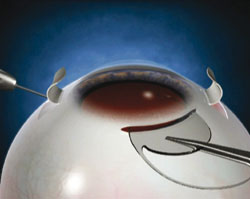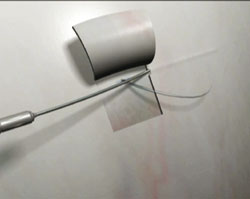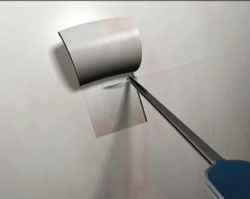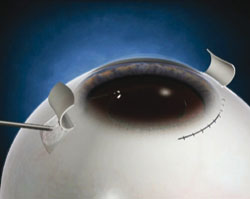Understanding the nuances of the glued IOL
Surgeons explain the advantages of using fibrin glue when implanting an IOL.
 Amar Agarwal |
The glued IOL is a new concept aimed at fixing a posterior chamber IOL in eyes with no capsule.
The glued IOL technique (Figure 1) consists of making two partial thickness scleral flaps exactly 180° apart followed by a sclerotomy with a 22-gauge needle 1 mm from the limbus. Then, 25-gauge MicroSurgical Technology forceps passed through the sclerotomy grasp the IOL haptic, which is then brought out onto the ocular surface (Figure 1a). Tunnels are made at the edge of the flap with a 26-gauge needle (Figure 1b) into which the two haptics are then tucked for additional stability (Figure 1c). The scleral flaps are then glued back into place using biological glue (Figure 1d). The IOLs that can be used are the three-piece foldable IOLs with slightly firm haptics or a non-foldable IOL.
 Figure 1a. IOL haptic grasped with MicroSurgical Technology forceps. |
 Figure 1b. Twenty-six gauge needle creates a scleral pocket at the edge of the flap. Images: Agarwal A |
 Figure 1c. IOL haptic tucked into the scleral pocket. |
 Figure 1d. Fibrin glue applied under the scleral flaps. |
Stability of the IOL haptic
The glue that we use is a quick-acting surgical fibrin glue sealant derived from human blood plasma (Tisseel, Baxter), with both hemostatic and adhesive properties.
As the flaps are manually created, the rough apposing surfaces of the flap and bed heal rapidly and firmly around the haptic, being helped by the fibrin glue early on. The major uncertainty here is the stability of the fibrin matrix in vivo. Numerous animal studies have shown that the fibrin glue is still present at 4 to 6 weeks. Because postoperative fibrosis starts early, the flaps become stuck secondary to fibrosis even before full degradation of the glue. The ensuing fibrosis acts as a firm scaffold around the haptic, which prevents movement along the long axis (Figure 2a).
 Figure 2a. Long axis movement is prevented by the tissue glue. |
 Figure 2b. Transverse axis movement is prevented by the scleral tuck. |
To further make the IOL rock steady, we have started tucking the haptic tip into the scleral wall through a tunnel. This prevents all movement of the haptic along the transverse axis as well (Figure 2b). The stability of the lens first comes through the tucking of the haptics in the scleral pocket created. The tissue glue then gives it extra stability and also seals the flap down. Externalization of the greater part of the haptics along its curvature stabilizes the axial positioning of the IOL and thereby prevents any IOL tilt.
IOL memory and tilt
The two factors that contribute to the ability of IOL loops to maintain their original symmetrical configuration are loop rigidity — the resistance of the haptic to external forces that act to bend the loops centrally — and loop memory — the ability of the loops to re-expand laterally to their original size and configuration.
Loop rigidity is seen as the centrifugal force vector of the haptics that resists compression by the capsular bag in an in-the-bag IOL. Loop memory is responsible for the gently stretched haptics following the globe curvature and creating a centripetal force that, along with the intralamellar scleral tuck, stabilizes the IOL. These two concepts can be understood by compressing or stretching the haptics in vitro.
Another issue to be addressed is IOL centration and tilt. Using optical coherence tomography, we measured IOL centration with dilated pupil on retroillumination slit lamp photographs processed with Matlab version 7.1. IOL tilt was assessed using the anterior segment OCT and also by assessing the change in the third and fourth Purkinje images. Difference in the topographic (Orbscan) and manifest refraction was also found to be constant in all eyes during the entire postoperative period, which was suggestive of minimal new IOL-induced astigmatism.
In our study, centration of the IOL was good with no detection of IOL tilt. Postoperative follow-up anterior segment OCT also showed perfect scleral flap adhesion as early as day 1, which continued at 1 week and 1 month. Two weeks’ continuous immersion of the IOL with haptics on stretch in a water bath with balanced salt solution maintained at body temperature did not show any change in measurements from pre- to post-immersion. Neither was there any change with drying after 2 weeks.
Glued vs. sutured scleral-fixated IOL
We also did cadaver studies on glued IOL vs. sutured scleral-fixated IOL. We applied graded pressure using first a mercury barometer and then known weights placed on both the IOLs. We saw that the glued IOL showed on par or better results as compared with the sutured scleral-fixated IOL. Although we did see iridodonesis as in many in-the-bag IOLs, we noticed that there was a lack of pseudophakodonesis. The steady configuration of this IOL as compared with the sutured scleral-fixated IOL would result in less endophthalmodonesis and hence decreased complications such as postop retinal detachment or cystoid macular edema.
IOL implantation in eyes that lack posterior capsular support has been accomplished in the past by using iris-fixated IOLs, anterior chamber IOLs and transscleral IOL fixation through the ciliary sulcus or pars plana. Surgical expertise, prolonged surgical time, suture-induced inflammation, suture degradation, and delayed IOL subluxation or dislocation due to broken suture are some of the limitations in sutured scleral-fixated IOL. It is also difficult and time-consuming, requiring minute and perfect adjustment of suture length and tension to ensure good centration of the scleral-fixated IOL.
The other advantage of the glued IOL is that in case of intraoperative capsular loss, one does not need to have an entire inventory of special scleral-fixated IOLs with eyelets, unlike with sutured scleral-fixated IOLs.
Indications
We have implanted multifocal glued IOLs with the ReZoom (Abbott Medical Optics), ReSTOR (Alcon) and Tecnis (AMO) IOLs. This makes it possible to offer the accommodative IOL advantage even to patients with an absent capsule. These IOLs cannot be implanted via any other mode, including suturing. The modified Prolene polyvinylidene fluoride haptic in these IOLs helps in being more stiff as well as having superior memory. Sutured scleral-fixated IOLs in pediatric eyes have been known to be associated with problems. We have had good results in multiple complicated pediatric glued IOL situations, such as homocystinuria with subluxation, aniridia with cataractous subluxated lens, Weill-Marchesani syndrome with microspherophakia and glaucoma. In dislocated posterior chamber PMMA IOL, the same IOL can be repositioned, thereby reducing the need for further manipulation.

- Amar Agarwal, MS, FRCS, FRCOphth, is director of Dr. Agarwal’s Eye Hospital and Eye Research Centre. Prof. Agarwal is the author of several books published by SLACK Incorporated, publisher of Ocular Surgery News, including Phaco Nightmares: Conquering Cataract Catastrophes, Bimanual Phaco: Mastering the Phakonit/MICS Technique, Dry Eye: A Practical Guide to Ocular Surface Disorders and Stem Cell Surgery and Presbyopia: A Surgical Textbook. He can be reached at 19 Cathedral Road, Chennai 600 086, India; fax: 91-44-28115871; e-mail: dragarwal@vsnl.com; Web site: www.dragarwal.com.









